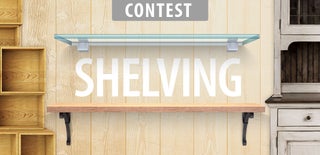Introduction: Organizer for Leather Working Tools
This instructable will walk you through making a white oak faced tool organizer for leather working. The idea is to keep everything easy to reach, and easy enough to put back to keep a stack of tools accumulating on the bench. This uses square holes slightly larger than the shaft of the largest stamp, and has a couple of trays for swivel knives, skivers, and so on.
I chose white oak because it is one of my favorites in terms of looks. In practice, it is prone to burning and splitting. If you don't mind dealing with the drawbacks, it looks great if you spray some ammonia cleaner on it to darken the wood a bit, then hit it with some rattle-can polyurethane. Maple or poplar would be good choices if you want an easier material to work. The ends are capped with pebble texture leather, mostly to hide the staple marks. The top tray is lined with a high wool content felt.
This project was made in a full wood shop. You could hand cut all sixty dividers, but it would take about a week. I started with some resawn white oak, then ripped to width on the table saw, and crosscut to length on the chopsaw. Fine tuning is done with a hand plane, but you need a good traditional bench for work holding. You can hand sand as an alternative, but it will take a while.
I browsed several Instructables to get inspiration for this project. Here are some similar tool organizers:
Step 1: Cut Divider Bars
The divider bars are sized the same 1/2" thickness as the plywood for the carcass.
Make sure your table saw fence isn't pinching on the outfeed side, and use a zero clearance insert so the narrow piece doesn't flip up and bind between the blade and insert.
Step 2: Drill, Nail and Set the Dividers
Cut the plywood tray for the dividers to the width of a divider plus the length of a divider. The same stock for the dividers is used to cover the exposed plywood edge. Cut extra pieces for the top and ends.
Normally I find Dremel tools dainty little tools that aren't good for any real work. They spin way too fast, and don't have any torque. But in this case, they will spin a tiny drill bit fast enough that it will punch and burn its way through thin wood without slowing down. I lined the dividers up on the bench, and worked my way down one end, then the other. With over one hundred holes to drill, keep things close together to minimize work motions.
Nail in place, using a divider as a spacer to leave a square opening slightly wider than the largest leather tool. Use a second divider to space the overhang that will be filled with a face frame.
I re-ground my nail set to look more like a drift punch. Any taper on the punch tip will wedge in and split the white oak, if you use a different species like maple or poplar, it will be much less prone to splitting.
Step 3: Glue and Clamp the Divider Trays
These aren't going to take a huge load, so there is just a light bead of glue on one side. Clamp it all together, leaving a little extra material on the end pieces to work as a the sides of a tray.
Step 4: Hand Plane the Face Frame
Take a little off the face frames to get them to fit between the protruding dividers. Pre-drill the face frames, glue and tack in place. Do a little better job fully covering both the plywood ends and the oak strip with glue, then tack in place.
Step 5: Plane Chamfers on the Top Tray
Plane then long edges of the angled top tray. Cut and glue in a back piece (not shown), then nail and glue the angled tray in place. Glue down good felt (shown in another instructable I did), countersink for sheet metal screws. Pre-finish the little shelves, then glue down. I used spray poly that dries in about five minutes.
Step 6: Cut Leather for the Ends
I won some pebble textured leather in the Tandy leatherworking contest. Since this is holding leather working tools, and since I glued one end on backwards, then pulled it off leaving big staple holes and glue smears, I covered the ends with leather.
Step 7: Ready for Work
Not wanting to do this project again, I tried to leave about twice as many openings for tools as what I currently have.

Participated in the
Remix Contest 2016

Participated in the
Shelving Contest 2016













